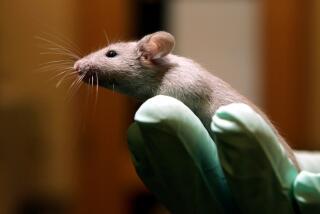Clone Is One Step in Extended Process
The report of a successfully cloned human embryo was a milestone in the field of stem cell research, but the medical promise of such endeavors still lies years in the future, scientists said Thursday.
Cloning human embryos to a stage in which stem cells can be extracted would theoretically permit scientists to create genetically matched tissues that could be inserted into patients’ bodies to treat illnesses such as diabetes, Parkinson’s disease and multiple sclerosis.
Because the tissues are perfect genetic matches to the patient, they are unlikely to be rejected by the body’s immune system.
But before stem cell therapy can be used in medicine, many hurdles must be overcome. The achievement of South Korean scientists in cloning a human embryo and extracting stem cells is one of many necessary breakthroughs.
It will probably be years before the treatments become a reality. Scientists must learn how to create specific body cells with sufficient purity, longevity and stability.
“It’s like herding cats, trying to get these cells to all do the same thing,” said David Anderson, professor of biology at Caltech. “They start whispering among each other and all go off in different directions to form different tissues.”
Researchers must also show that such tissues can be safely inserted into a test animal and perform the functions of the cells they were meant to be.
Finally, researchers must show that the therapy works in people. A patient with diabetes, for example, could be helped with stem cells that had been coaxed into becoming insulin-secreting cells, boosting the body’s insulin-producing ability.
So far, the overwhelming majority of such work has been conducted not with human embryonic cells but animal cells. The work is based on decades of research into the basic nuts and bolts of embryo development. There have been some impressive results.
In one instance, researchers at Columbia University used a complex series of chemical treatments to turn an embryonic stem cell into a type of nerve cell called a motor neuron.
First they turned it into a generic nerve cell, capable of becoming many kinds of nerves. Then they gave it additional chemical treatments to prod it into becoming a motor neuron.
The scientists grafted the cells into chicken embryos. The cells appeared to link up with other nerves just as if they were motor neurons.
In another experiment, a group at the National Institutes of Health created cells that secrete the key brain chemical dopamine, which is deficient in patients with Parkinson’s disease.
When the cells were grafted into the brains of mice with a Parkinson’s-like condition, certain behaviors (such as the ability to grasp food with both paws) were improved, said Ron McKay, the NIH stem cell researcher whose lab conducted the experiment.
“I want to avoid saying the mice were cured; we’ve got a long way to go,” McKay said. “But it does look promising.”
Other areas of stem cell research are not as advanced. For instance, some scientists have reported the creation of insulin-secreting cells, but other scientists have challenged that claim. They said the cells were sucking up insulin from the culture medium they were grown in and spitting it out again.
Since the biology of mice and humans is so similar, findings in rodents are likely to be widely applicable, but they will not be directly transferable. Scientists know there are subtle differences in the chemical pathways that nudge mouse or human cells down one path or another in biological development.
This means direct experimentation with human embryonic stem cells is also crucial, researchers said.
Human stem cell research is not as far along, although in recent years scientists have learned how to make stem cells turn into a few types of cells.
Federal funding for human stem cell research is granted for use with a small number of stem cell lines.






